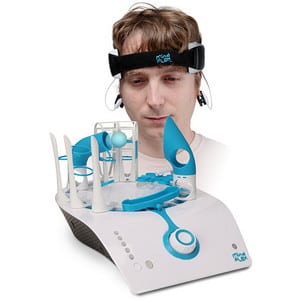 Mindflex is a game that takes things to the next level, literally. You don’t use your hands much, and the idea is that your brain is controlling the action here. Critics say it’s not really your brain that’s controlling much at all, but it still seems to entertain people and gives the appearance that it works. So what’s really going on here?
Mindflex is a game that takes things to the next level, literally. You don’t use your hands much, and the idea is that your brain is controlling the action here. Critics say it’s not really your brain that’s controlling much at all, but it still seems to entertain people and gives the appearance that it works. So what’s really going on here?
Overview
The boardgame industry is actually a pretty competitive marketplace, and all of the companies will always try to outdo each other. Mattel is taking things to a whole new realm by incorporating something as scientific as your neuro-activity and making a game of it. Some say that is is nothing but a farce, or novelty item, while others claim that the game really does respond to their level of concentration and they enjoy manipulating the ball through the different obstacles on the board.
The Claim and Criticism
The claim is that it’s your brain waves, or brain activity that is controlling the ball. Critics say that is not the case at all, and that the game is actually doing the manipulating of the ball regardless of what your brain is doing. It wouldn’t take much for the game to simulate different actions, and if you take the blame for what the ball does even if it doing something that you don’t think you’re causing, they’ve got you.
For example if you want the ball to go one way and it goes the other, you might just assume that your brain is the problem, when in fact it’s not correlating your brain activity to the ball’s activity at all.
The Hype
As technology advances things like this become more more feasible as something that could work. We can expect more things like this to come in the future, including virtual-reality machines and 3-D aiming systems that immerse us in different worlds. But today might not be the day where we are able to control games using our brain waves.
The Cost
You can find Mindflex online or in stores for around $80. For a game made by Mattel that’s on the high side of things, so you better be sure that huddling around a machine that blows a ball around is something you want yourself or your kids to be doing.
The Commitment
You have to commit to wearing the rather cumbersome headset that puts sensors on your temples and also connects clamps to your earlobes. Some say this allows the machine to pick up on your brain waves, but critics of claim that it’s just an elaborate getup to make you believe that it’s actually connecting to your brain in the first place.
Evaluation
Some users point out that it’s actually a fan that is making the ball float in the air, but the claims made by Mattel are not that your mind is making the ball float, just that your level of concentration is controlling how hard the fan blows. After observing repeated uses of the device, it’s pretty clear to see that the machine pretty much just does what it wants, and also allows you to manually override it with control knob.
Mindflex Duel
While Mindflex is designed for just one person to keep themselves busy with a mental obstacle course, Mindflex Duel pits your concentration against an opponent to see who can focus more. You might feel a little silly literally going head-to-head with your opponent, but it could be fun to see who is able to focus their mind more than the other.
Final Mindflex Review
It’s hard to watch people using Mindflex and thinking that they’re having a good time. It seems like it’s not very fun, and would only be a novelty item that loses its appeal after a few minutes. Our opinion is that the game creates the illusion that you’re actually moving the ball at your mind, but really it’s just on random and your brain is actually compensating for the difference.
Our Recommendation
Since Mindflex is considered a game, we have to compare it and contrasted against the other more successful games out there. We still prefer a good old game of Monopoly over something like this, as it gets you involved with other people, and still requires a good amount of mental focus and concentration. In our opinion it is more fun to out-think your opponent than it is to out-concentrate them.



I am so surprised to see so many reviews that are not flattering about this product. I was extremely skeptical when I purchased this item and I was very anxious to try it out. I read the direction several times to make sure I put the headset on correctly and followed other procedures. I believe some of the individuals who have trouble with this product simply did not follow the very specific directions. It only took a short while for me to make the ball rise, but I had to concentrate a bit longer to obtain maximum height. I found it interesting that determined concentration did not work as well as relaxed concentration. I also found it interesting that concentrating on the ball while doing math problems (as suggested in the instruction booklet) really worked! I was also very impressed that I could concentrate and raise the ball then look away and the ball would drop almost immediately. I did experiments like this that proved to me the speed of the fan was actually being controlled by my brainwaves and was not using some random program to make you think you were controlling the fan. I even turned the machine on without putting the headset on and to my surprise the device informed me that the headset was not being used properly! After I tested (and played) with this product for an hour, I decided to see how it worked when my wife tried it. I was amazed at her ability to control the ball. She immediately maxed the speed of the fan and got the ball to rise to its highest level. It took me much longer to obtain the greater heights. She was even able to look away and talk and continue to make the ball levitate! I was unable to do that. I do believe this product is going to be appreciated by teenagers and adult much more than younger children. I can see how they might get bored with it quickly. This is an expensive item and I don’t know if I would pay over $100 for it, but I was able to purchase mine used for a much lower price and it is well worth the price I paid. It is supposed to be a gift for a grandchild, but I enjoyed it so much I want to keep it for myself!
Sure you have.
I have opened up the headset and hooked it up to an arduino to read my brainwaves. Don’t write about things you haven’t researched well enough.
The reviewer must never have actually tried the game, otherwise they would know the vertical movement is controlled via the headset while horizontal movement is controlled by the dial. I picked up the game for my son, who suffered from a traumatic brain injury. He was able to raise and lower the ball on command, not random. Also, could raise the ball to a specific height to maneuver past an obstacle placed randomly on the layout. The obstacle is plastic with no sensors. If you are going to review items in the future, I suggest you do more than read other websites and do the job for which you were paid. While this is merely a toy, with no claims otherwise, I find the technology interesting and open to possibilities. The sensor technology in the unit has many possible uses as is evidenced by the chip makers foray into headsets designed to interface with android devices.
*you’re
If you don’t think this game works there are only 2 possibilities. A) Your an idiot. Or b) its quite possible, your an idiot and have never tried it.
If you concentrate it moves. If you don’t it stays still. Up to you.
It really does work. You can’t ‘think the ball up’ or ‘think the ball down’ but if you relax or stress your thinking it moves, and it does this very reliably and repeatedly. You have to have good control over how you concentrate – I suspect that the more excitable among us are going to have more problems with control, and the more ‘concrete’ thinkers are going to find it easy – this is certainly true amongst my kids!
Don’t be a naysayer if it doesn’t work for you – I know that it doesn’t work well for everyone. Find the most ‘concrete’ thinker that you know – and watch them move the ball up and down, completely at their will. It’s not a ‘fail’ if it doesn’t work well for you – it means that your brain operates differently (and in probably ways that we need just as much – or more – than us concrete thinkers).
We really do need many different kinds of brains to survive. Concrete thinkers are usually the least able to ‘think out of the box’, which is definitely a major survival skill!
Recommend researching the neuroscience behind this game to see why it does work.